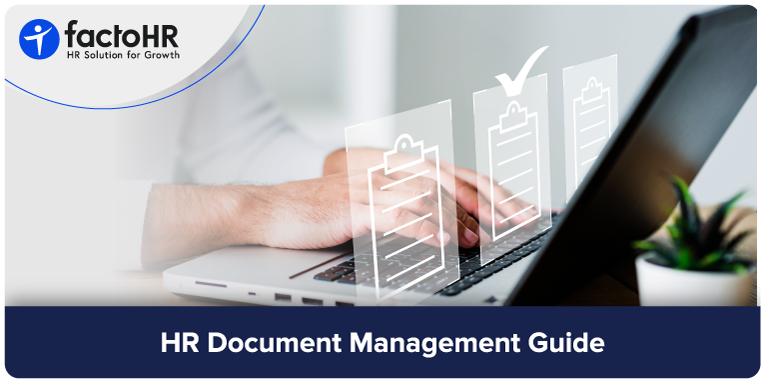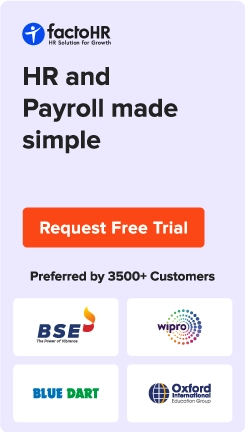HR Document Management: Step-by-Step Implementation Guide

Table of Contents
In this information-led era, can HR professionals manage their documentation process smartly and efficiently? Is it possible for an organization to make every policy or contract accessible from anywhere? This is possible when HR teams implement HR document management systems. In a Ṅtraditional format, HR teams stored their information in a filing system or through folders. This format has various challenges, like data duplication and difficulty sharing data across teams. This is why it is necessary to have a document management system in an organization.
This article focuses on the benefits of implementing an HR documentation system and provides a step-by-step guide for HR professionals. We have also discussed some common challenges that can be solved along with best practices.
What is an HR Document Management System?
A human resources document management system is software that helps store and retrieve documents related to employee data. It provides centralized digital storage, which makes documents manageable and helps reduce the need for physical filing. This system protects documents from unauthorized access by securing them through access controls and encryption. HR professionals can focus more on other important HR decisions as their manual tasks are reduced. For more understanding, below mentioned are the types of documents that can be managed.
- Resumes and cover letters
- Employee onboarding forms
- Benefit enrollment forms
- Disciplinary actions
- Employment contracts
- Performance reviews
- Benefits enrollment forms
- Time sheets

Why Implement an HR Document Management System?
An HR document management system has multiple benefits, like a centralized storage system and remaining compliant with laws. Some of these benefits are mentioned below to help understand why it is important to implement HR document automation
Enhanced Document Accessibility
The system digitizes and centralizes documents, which makes them easy to access. As the information is available in just one click, teams can collaborate easily and efficiently. This way, response times and errors are reduced, which helps organizations increase productivity.
Enhanced Collaboration
A human resources document management system allows collaboration among team members as multiple users can access the documents. The employee’s location is irrelevant; their performance remains unchanged whether they work from the office or at home. DMS allows teams to work efficiently, make informed decisions, and save time for other important tasks.
Document Integrity
The system also offers control capabilities essential for maintaining document changes and integrity. It helps avoid confusion, as employees can refer to the history of document revisions and track changes. It also records all the approvals and clarifications given to maintain legal compliance.
Document Security
An HR document management solution is protected through strong security measures to save employees’ sensitive information. It provides authorized access to those employees who have permission. It can integrate encryption and automated backups to help save data from loss.
Efficient Workflows
The system can simplify routine tasks, like document routing, reducing manual interventions. Organizations and HR professionals can save time and reduce the cost of errors, which helps them allocate their resources effectively. Automating routine tasks can help increase an organization’s operational efficiency.
Effective Compliance Management
Proper compliance is maintained with the help of the document management system by accurate record-keeping and tracking changes. It simplifies the compliance process of document retention and audit trails. Organizations can eliminate risks and penalties related to non-compliance by maintaining accurate records.

Here is a Step-by-Step Implementation Guide for the Human Resources Document Management System
Implementing an HR document management system can be challenging for almost every organization. To make this process smooth, we have mentioned a step-by-step implementation guide for the HR document management system. Here are:
Step 1: Assess Current Document Practices
To start the process, it is important to understand the current document management system. The current system’s workflow processes and storage types help identify areas for development. Companies require some features, like security measures and approval processes.
Step 2: Define Goals and Requirements
After assessing the current HR document management solution, define organizational goals and requirements. Some of these goals include reducing time spent retrieving documents and maintaining compliance. Know the requirements for the types of documents that will be managed on the DMS and make informed decisions.
Step 3: Select the Right HR DMS Software
Choose a system that can manage the increasing volume of HR documentation and has some other unique features. These include integration capabilities with third-party applications and user-friendly interfaces. Some of the HR software features should include customization and DMS software.
Step 4: Plan Folder Structure and Access Controls
The next step includes an organized system for storing the data. Documents can be classified as employee files and performance reviews, making retrieval easy. Those employees who will be accessing the documents should be identified, and access controls should be given to them.
Step 5: Digitize and Migrate Existing Documents
Once the access controls are identified and the right software is selected, transfer the HR documents into the chosen DMS. Use keywords to make the search process easier and the system more useful and functional. Test the system to identify errors and take corrective actions.
Step 6: Train HR Staff and End Users
Adapting to the newly implemented system is always challenging, but this issue can be addressed by offering training programs. These learning sessions should include practical demonstrations so that employees understand how to use the system. Also, provide specialized training to HR professionals to manage document workflows and to employees to access their files.
Step 7: Monitor Usage and Optimize Processes
Once the system is set, track the adoption metrics, like the number of logins, to understand the performance of the system. Get insights on how the users are interacting with the system and identify patterns. Gather feedback through survey forms and informal discussions to improve the system. employee management platform helps automate repetitive tasks, which can save time for HR professionals to focus on other important tasks.

Best Practices for HR Document Management
We have mentioned some of the general best practices that organizations can follow. Here are a few:
Organize & Categorize Documents
Identify the types of HR documents needed in the organization and categorize them accordingly. Some examples include onboarding and compliance-related documents. The system allows a quick and easy document search and retrieval process with the help of technology.
Regular Audit
It is beneficial for organizations to conduct an audit process at least once a year. The audit trail should be undertaken to maintain compliance and reduce data redundancy, which helps increase operational efficiency.
Establish a Recovery Plan
Many organizations have a recovery plan in times of contingency or disaster. Keep a backup of important files and include off-site storage to avoid data loss. Technical errors or cyberattacks can result in data loss.
Use of Technology
Using technology can help organizations detect missing documents without needing human intervention. It can also help simplify HR processes by routing the HR documents to individuals with authorized access.
Control Document Accesses
An HR document management software should offer role-based access options to keep the documents safe. Data security becomes easier when authorized employees have access. The system should also provide data encryption features to prevent data leaks or misuse.

What are the Common Challenges and How to Overcome Them?
Managing documents is beneficial for all organizations, but the system has some challenges. Here are some of the common challenges and solutions to address them.
Data Migration Issues
It is important to start with proper planning; otherwise, the process can lead to errors. Also, large volumes of data can sometimes lead to data corruption or loss, which disrupts the daily operations in the organization.
Solution: Develop a detailed plan and choose the right HR tool to avoid any risks or delays. Conduct trials to identify issues and take corrective actions to solve them.
Resistance to Change
Employees are set with the current system, and generally, there is a resistance to change. They have a fear of the unknown and a lack of understanding of the new system introduced in the firm. They wish to adhere to the methods they are familiar with and prefer to maintain control over their task management.
Solution: Let employees know the reasons why there is a change in the system and educate them on the benefits of the software. Conduct surveys to understand why there is resistance to change and acknowledge these issues by providing proper reasoning. Provide training sessions to help employees navigate through the system easily.
Integration Difficulties with an Existing HR Tech Stack
Integrating a new HR document management system can be difficult, as it can lead to data inconsistency or incompatible APIs. Different systems might have difficulty sharing information across teams, leading to delays in the decision-making process.
Solution: Evaluate the current HR systems to identify areas of improvement or challenges. Managers should educate their team members to help them understand why the system is introduced and what the goals are for the HR integration process.
Data Security
Non-compliance can result in financial penalties from GDPR and damage the brand’s reputation. HR documents contain sensitive information, like financial details and phone numbers, which can be leaked or breached.
Solution: To avoid phishing, the selected DMS should include multi-factor authentication and data encryption. Practice ethical hacking and regular scans to find any weaknesses in the system.
Conclusion
A structured and step-wise approach helps implement an HR document management system successfully. This approach starts by identifying the current document system and identifying gaps, such as security risks. Choosing the right DMS helps organize and manage data efficiently, reducing the need for physical filing. Training and learning programs help with the adoption of systems, and organizations can stay efficient as they grow.
Grow your business with factoHR today
Focus on the significant decision-making tasks, transfer all your common repetitive HR tasks to factoHR and see the things falling into their place.

© 2025 Copyright factoHR


